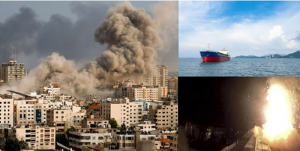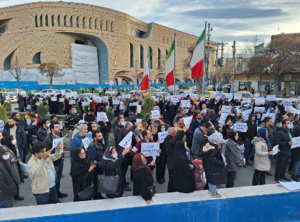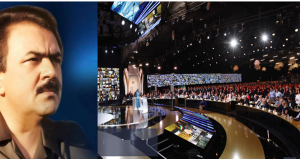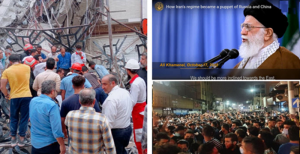(Video) Beyond Borders: Iran's Regional Aggression and the Silent Threats Within

Since Oct. 2023, global attention has been seized by a conflict that unfolded in the Middle East. Initially, questions arose regarding the Iranian regime’s role in sparking this conflict. But it is now acknowledged that the regime has inflamed the entire region.

Abbas Abdi, a former interrogator, " Without effective and sustainable resolutions, we should anticipate a bleak future. Budget disparities, banking imbalances, energy discrepancies, water disparages, and now population imbalances are emerging issues.”

Mehdi Rouhani Far, introduced as an expert “The PMOI possesses financial and capital capabilities, as well as human resources and assets, along with alliances in various countries that have conflicts with the Islamic Republic and are striving for its overthrow."
Entekhab Website, " Iran is grappling with several serious disparities, and without effective and sustainable resolutions, we should anticipate a bleak future."
Tehran’s primary objective in fomenting this crisis was to divert attention from the precarious internal state of the regime and the volatile conditions within Iranian society.
The Supreme Leader Ali Khamenei, grappling with widespread discontent and ongoing uprisings, feared his own overthrow during the 2022 uprising. While this uprising was temporarily quelled through brutal suppression, Khamenei is aware that fundamental issues in Iranian society remain unaddressed. Public discontent is on the rise, and despite widespread arrests, daily protests and nightly skirmishes persist, keeping the embers of the uprising alit.
Despite the clerical regime’s reliance on increasing executions and suppressive regulations, along with claims of successfully quelling uprisings, a pervasive network of Resistance Units connected to the organized Resistance movement has markedly intensified its operations nationwide. These activities boldly challenge the regime’s extensive security apparatus, exposing its ineffectiveness.
In this challenging context, the regime’s recurring strategy is to export crises abroad a tactic employed consistently over more than four decades.
During its initial years, the mullahs’ regime sparked the flames of the eight-year Iran-Iraq war to avoid meeting the demands of the newly revolutionized Iranian society. Considered a “divine blessing” by its former Supreme Leader Ruhollah Khomeini, the war allowed the regime to suppress opposing forces, notably the People’s Mojahedin of Iran (PMOI/MEK), and veil administrative failure and public dissatisfaction.
Similarly, following the nationwide uprising in Iran in 2022, Khamenei resorted to the same playbook.
An analysis of Iran’s socioeconomic statistics, coupled with constant warnings from state officials and the state-affiliated media shows that the clerical regime’s involvement in external conflicts is not a demonstration of strength but rather a means to run away from its profound domestic vulnerabilities.
Official statements of dismay
The convergence of socio-economic challenges and escalating political repression has transformed Iranian society into a rumbling volcano. This volatile mix has frequently erupted into significant protests and uprisings nationwide. As the regime continues to fall short in addressing the root issues, insiders persistently warn about inevitable troubles.
On January 13, the Secretary-General of the Islamic Iran Nation Party Azar Mansouri said, “Given a 40% inflation rate and a 20% wage increase, it is evident that the income for different groups, including workers, teachers, retirees, and various professions, falls short of meeting their daily expenses.
The increasing percentage of the population living below the poverty line reflects the rapid decline of the middle class in Iran, with the impoverished segment experiencing further deterioration. If we cannot describe this situation as insecurity, what term would be fitting for this trend of diminishing the resources available to people?”
Mansouri warned, “Recent multifaceted protests, spanning from December 2017 to November 2019 and September 2022, have demonstrated an underlying accumulation of dissatisfaction and anger beneath the surface of society, emerging during opportune moments. This society shouldn’t live in daily worry about whether tomorrow’s circumstances will be worse than today’s.”
On January 19, 2022, Mohsen Ranani, a university professor and an analyst with affiliations to the state, made a significant statement on the Telegram channel Tahlil-e-Zamaneh. “There is virtually no hope remaining for the state,” he said.
“The system has been depleted of authentic thinkers and collective wisdom, overtaken by individuals seeking personal gains to an extent where the potential for meaningful change has been extinguished. Without fundamental structural changes and a forward-looking perspective, there is no conceivable escape from the current predicament for the state. However, visualizing a path forward necessitates a substantial amount of self-confidence and intellectual vigor, attributes that are no longer discernible within the existing power structure.”
Secretary-General of the Kargozaran Party Hossein Marashi warned in January 2023, “In my view, the crucial factor, acknowledged and discussed by the government in various sessions, is the widespread discontent. If those dissatisfied take to the streets, no one can put up with them, as over 75% of the Iranian population expresses dissatisfaction. We have a significant dissatisfied population, a portion of whom actively protest in the streets, and a small fraction might resort to causing disturbances.”
In an interview with state-affiliated Didar News on January 11, former Kayhan newspaper editor-in-chief Mehdi Nasiri said, “The Islamic Republic relies more on its prisons, prison guards, interrogators, and pellet guns than on reform, dialogue, and engaging with society. The leadership insisted on having elections to prevent the country from turning into a dictatorship. As if we were living in a democracy. Is the Islamic Republic a democratic system? Then what does the concept of dictatorship even mean?”
In a January 24, 2023, column for the Entekhab Website, Abbas Abdi, a former intelligence interrogator, wrote, “Public sentiment towards current politics and management is mostly negative, with only a small fraction defending the current state. Recent polls suggest that only 7% advocate for the existing situation. There seems to be a consensus that Iran is grappling with several serious disparities, and without effective and sustainable resolutions, we should anticipate a bleak future. Budget disparities, banking imbalances, energy discrepancies, water disparages, and now population imbalances are emerging issues.”
In July 2023, the Jomhouri Eslami newspaper issued a stark warning: “Don’t presume the people’s patience is unlimited. Beware of the day when the army of the hungry rises against you. If you fail in your religious and legal duty to serve the deprived and uphold justice, at least contemplate the consequences for your own survival and governance.”
Warning against the organized Resistance
Amidst repeated warnings of an imminent revolution, both former and current state officials are increasingly cautioning against what the regime identifies as a major threat. Every Tuesday in Tehran, the regime stages a show trial of over a hundred members of the PMOI and the NCRI.
These orchestrated court proceedings are a spectacle for state media to disseminate fabricated stories and narratives about the perceived dangers posed by the Iranian Resistance.
Moreover, the regime consistently generates literature across various mediums movies, TV series, books, magazines, website posts, and daily newspapers replete with narratives portraying the PMOI as perpetrators of atrocities and a threat to the Iranian public.
Alongside the elevated intensity of the regime’s messaging on this subject, statements from certain officials offer more revealing insights into this matter.
On December 12, in a detailed report on the first session of the sham trial, the IRGC-run Fars News Agency referred to the PMOI as “hypocrites” and emphasized the need to confront them, writing, “The danger of hypocrites to any society is greater than the danger of other enemies because understanding them is often not easy. They are internal enemies and sometimes infiltrate society to such an extent that distinguishing them becomes extremely difficult.”
During an interview with the state-run Etemad online about the PMOI and its current role in Iranian society, Javad Muguee, a documentary director closely associated with the regime’s intelligence community and self-identified as an expert on the PMOI, stated, “The PMOI underwent a complete restructuring in Iran’s public perception during the 2000s. They assumed a prominent role in the 2010s, and the 1988 executions became the central topic of the 2017 presidential election.”
During an interview with the state-run Farhikhtegan newspaper on December 2, Leili Aj, a state-affiliated film director who recently released a new movie against the PMOI, disclosed that many of her peers and coworkers boycotted her after the movie became public. She wryly commented, “I didn’t know that the PMOI had so many secret sympathizers.”
On a state-organized radio show in August 2023, several insiders and so-called dissident experts discussed the threat posed by the organization in length. Mehdi Nejati, a cyber political activist said, “We shouldn’t casually overlook the PMOI’s change in strategy and transformation. Their current approach is far more dangerous than the previous one.”
Discussing the 2022 uprising, Nejati remarked, “Some of these protests imposed costs, not just on the people but also on the security forces. Part of it was in line with the people’s legitimate demands. However, why did it take a misguided turn? It veered off course due to the presence of PMOI forces on the ground.”
Mehdi Rouhani Far, introduced as an expert in political affairs and terrorism also said, “The PMOI possesses financial and capital capabilities, as well as human resources and assets, along with alliances in various countries that have conflicts with the Islamic Republic system and are striving for its overthrow.
Taking the example of the protest issue surrounding the late Ms. Mahsa Amini, you can observe that almost all factions critical of the Islamic Republic and the opposition seeking overthrow are using an influential method. This method is the same as that of the PMOI, which indeed has experiences and history, organizational experience, and very effective tools that can be employed in the field. Other opposition factions can use this method. Overthrowing our state at any cost.”
Rouhani Far added, “The PMOI is one of the most significant factors contributing to tensions. Anyone with government responsibilities, resources, and authority must pay extremely close attention, and is necessary to consider two key aspects: 1) The threat posed by the organization is much greater than before, and 2) Developing an analysis of the reincarnation and transformation of this organization is of utmost importance.”
While one might contend that these talking points are primarily intended for a domestic audience, the regime’s Director of Human Rights Matters in the Judiciary, Kazem Gharibabadi, dispelled such arguments. In an interview on June 24, 2022, Gharibabadi admitted, “There is no meeting with ambassadors of European countries or delegations of European countries in which we do not bring up the issue of the Hypocrites.”
Economic hardship
According to reports from state media, the economic condition of the Iranian people has surpassed the point of crisis. Dreadful of an imminent revolution by the sheer masses of the hungry and grieved, insiders and state-affiliated experts warn that the status quo is destined for an all-out conflict with the country’s population.
In a report titled, “Heed the footsteps of a crisis larger than 2022, the state-run Eqtesad24 wrote on January 15, “If the country’s political leaders aim to prevent political challenges surpassing those of 2022, they must promptly address inequalities. Otherwise, they’ll have to accept the inherent consequences of their policies. It’s no longer viable to postpone reforms to the future or attribute forthcoming developments to external factors. Given the current economic state, officials must take immediate responsibility for potential future unrest.”
Corruption
As ordinary citizens grapple with daily economic challenges stemming from rising costs and the depreciation of their currency, the media occasionally unveil instances of extensive corruption and embezzlement. These revelations suggest that substantial funds have been directed toward government officials or private entities closely linked to the government.
State-tied corruption has been a persistent issue in Iran, hindering economic development, undermining public trust in institutions, and contributing to social unrest. This form of corruption involves government officials, politicians, and powerful individuals leveraging their positions for personal gain, often through illicit enrichment, kickbacks, and the misuse of public resources.
In December 2023, news broke about corruption in Iran’s tea industry. A commercial group entrusted with $3.37 billion for tea imports and machinery failed to fulfill its commitment. Out of the received funds, $1.4 billion remains unaccounted for, as the group sold government currencies at a higher market rate, anticipating the figure to reach almost $2 billion.
In August 2023, an Iranian parliamentary report revealed a significant embezzlement case at Mobarakeh Steel Company (MSC) in Isfahan. The investigation, which included 300,000 documents, demonstrated extensive fraud, bribery, and corruption across the regime’s establishment.
The sanctioned company embezzled 92 trillion tomans (around $5.25 billion) from March 2018 to December 2021. Despite officially being a major private business, MSC is under the control of the Revolutionary Guards (IRGC), managing around 3,000 factories and companies in the country.
The state’s response to these thefts includes occasional show trials, seemingly aimed at pacifying public anger by scapegoating a few managers. Despite these efforts, many officials are warning about the far-reaching consequences of corruption, recognizing it as a potential catalyst for public uprisings.
The former head of the National Security Commission of the regime’s parliament, Hashmatollah Fallahatpisheh, said on December 5, 2023, “The most significant instances of disgrace and embezzlement occurred during the thirteenth government, and it is evident that the parliament has chosen to remain silent. The citizens are now grappling with living standards reduced by more than 50%. The impact of inflation, escalating expenses, and economic hardships is weighing heavily on the people. Furthermore, there has been an unprecedented 150% increase in taxes, a measure not seen in global planning or in the history of Iran.”
On the same day, the state-run Jamaran website wrote: “They [the corrupt managers of Debsh Tea Company] only had $300 million in net profit on the spot. And yet, people inside the power structure still support this company! These relationships stem from a hidden economy within the Iranian government. For 30 years, an annual estimate of between 15 to 20 billion dollars of smuggled imports has been circulating in Iran. During these 30 years, various individuals in Iran have been presidents, but this figure has remained relatively constant with some fluctuations.”
Poverty
The social divide in Iran, under the rule of the clerics, has significantly widened. The immense wealth of one of the world’s richest nations is being monopolized by a centralized and corrupt ruling establishment, benefitting a privileged class of powerful millionaires, while ordinary citizens face increasing poverty each day.
A state-affiliated expert highlighted that “neither the banking system, tax system, nor the subsidy system has built-in mechanisms for wealth redistribution, resulting in a notable wealth accumulation in Iran.”
To view the whole text, please use the link below.
https://www.ncr-iran.org/en/news/iran-protests/behind-regional-aggression-iran-conceals-an-underlying-internal-peril/
To subscribe weekly Newsletter of NCRI, please use this link. https://bit.ly/3SMgEla
Shahin Gobadi
NCRI
+33 6 61 65 32 31
email us here
For decades, Iran has witnessed periodic protests, but since 2017, coinciding with the expansion of the PMOI Resistance Units network.
Legal Disclaimer:
EIN Presswire provides this news content "as is" without warranty of any kind. We do not accept any responsibility or liability for the accuracy, content, images, videos, licenses, completeness, legality, or reliability of the information contained in this article. If you have any complaints or copyright issues related to this article, kindly contact the author above.


